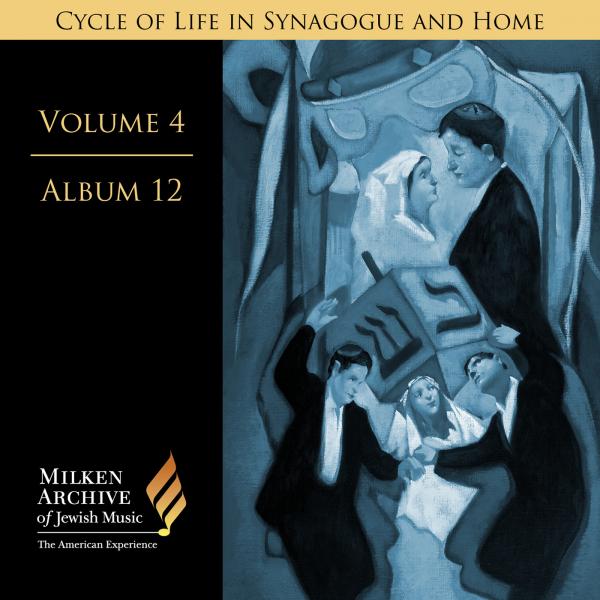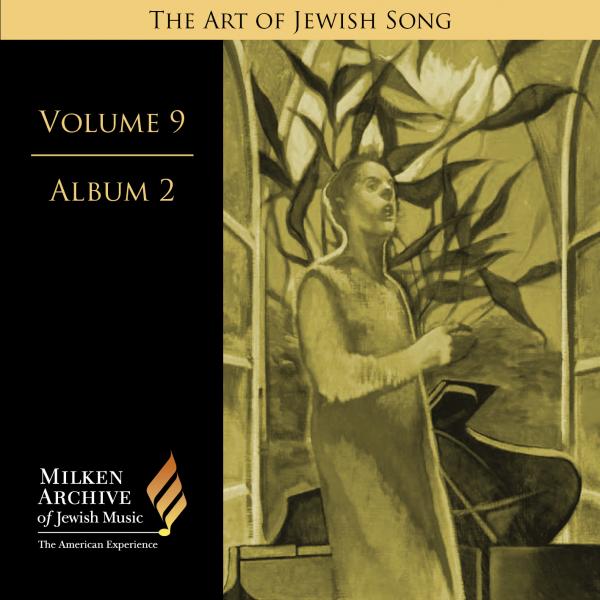The son of Borukh Hirsch, the respected local cantor of Karlin (the “Karliner Hazzan”), a town near Pinsk, Belarus, Mark Silver (1893–1965) was one of five younger brothers of the esteemed liturgical composer and choral director Zavel Zilberts. Though Silver never achieved (nor did he necessarily aspire to) his eldest brother’s prominence, he was highly respected in his own right as both a synagogue composer and a conductor of Jewish secular as well as synagogue choirs. A number of his compositions eventually earned places in the standard composite repertoire of traditionally oriented American synagogues—those within the fold of the Conservative movement as well as some of the more aesthetically sophisticated orthodox ones that flourished in his day.
Silver, who, along with Zilberts’s other younger brothers, modified his name to its English equivalent, was born in Pinsk, where he grew up singing in synagogue choirs and also commenced piano lessons as a young boy. He immigrated to America in 1909 and settled in New York. Shortly afterward, according to a biographical account relayed by his widow to Cantor Nathan Mendelson, a friend and colleague, Silver turned his attention to classical music—with an emphasis on modern developments in composition and conducting. He pursued studies in Columbia University’s music department, financing his education by playing piano and organ in New York theaters and cinema houses. During that time frame his teachers included Daniel Gregory Mason and Cornelius Rybner. Various biographical sketches refer to his receipt of the Mosenthal Fellowship at Columbia and to his having been awarded what is cited as the “Pulitzer Travelling Fellowship” in 1917. (Documentation concerning the latter has not been located; the well-known award known as the Pulitzer Prize [in music] was first bestowed in 1917.)
Silver enjoyed a new level of recognition as a serious composer when, in May 1925, his 1918 symphonic poem, Peace and War, received its premiere performance by the Rochester Philharmonic Orchestra conducted by Howard Hanson. That event marked the inaugural concert of the American Composers’ Concerts series—a project that Hanson, who had just completed the first year of his long tenure as director of the Eastman School of Music, initiated in order to encourage and promote the development of an indigenous American music. (Undocumented references to Silver’s receipt of the Pulitzer fellowship suggest that this piece was the catalyst for the prize in 1917, and that its selection for the inaugural concert was the result of his winning a competition sponsored by Eastman, for which he submitted that work. The completion date on the manuscript score, however, which may indicate a revised final version, is given as 1918). Silver found himself in good artistic company on that occasion, for the program included new works by such soon-to-be celebrated composers as Quincy Porter (Ukrainian Suite for string orchestra), Bernard Rogers (Soliloquy for Flute and Orchestra), and the promising twenty-five-year-old rising star Aaron Copland—whose “Cortege Macabre” from his one-act ballet score Grohg received its initial performance alongside Silver’s work.
Meanwhile, during the 1920s Silver taught piano and coached singers in his private studio in the Carnegie Hall building, which he opened in 1922; and he began conducting synagogue choirs in the New York area and in New Jersey. For a few years beginning in 1927, he conducted a string ensemble—indentified in some recollections as the “Jewish Little Symphony”—for broadcasts on radio station WMCA in New York. He composed Jewish-oriented pieces and arranged and orchestrated traditional Jewish folk material for that ensemble.
Over the ensuing years, Silver held posts as music director at several important synagogues, including Temple B’nai Abraham in Newark and Temple Beth El in South Orange and Maplewood, New Jersey. In 1930 he began his twenty-nine-year tenure as director of the Hazomir Choral Society in Newark, a concert chorus (previously directed by his eldest brother) that performed secular as well as liturgical Jewish works, for whom he wrote several cantatas and oratorios. He also directed the symphony orchestra sponsored by Newark’s YM/YWHA (Young Men’s and Young Women’s Hebrew Association), which he joined with Hazomir for many of its concerts.
Throughout the 1930s, 1940s, and 1950s Silver continued to compose, producing a solid catalogue (published as well as manuscript items) of Judaic concert works as well as numerous liturgical prayer settings and several choral folksong arrangements. As cantors and fellow choirmasters on the East Coast became increasingly aware of his work, some of those liturgical pieces came to be heard with some degree of frequency at their synagogue services; and through the dissemination of his published settings, his reputation spread across North America. Hebrew Union College–Jewish Institute of Religion honored him with its Jacob Weinberg award for his setting of a central piyyut of the Rosh Hashana and Yom Kippur musaf service, Unetane tokef. In approaching that text, Silver—as he told his friend Cantor Mendelson while working on the piece—imposed upon himself an interesting creative challenge: to transcribe from youthful memories his perception of what might have been a spontaneous rendition by a traditional eastern European–oriented ba’al t’filla (lay cantor or precentor), and to juxtapose those ornamented lines against more sophisticated, harmonically devised, and artistically structured supporting choral parts. What emerged was a “technically rich accompaniment [in the choral parts] to set off the ba’al t’filla’s inspiration,” as Cantor Mendelson recalled in a memorial article.
Among his larger liturgical works, Silver’s Sabbath eve service, Arvit l’shabbat, may be considered a model of his stylistic persona and desiderata. The solo cantorial lines, for example, echo much of the flavor of traditional Ashkenazi hazzanut—with ample fluidity and emotional expression, and even opportunities for modest ornamentation, but with the judicious restraint appropriate for what he perceived as a modern American format within traditional worship. Indeed, the publisher’s preface suggests that in this work, “the composer has tried to express his belief that … there need be no distinction in religious music between the Reform and orthodox”—that “traditional chant” applies (or should apply) to both orientations and, obviously, to nonorthodox traditional formats of the Conservative movement as well. Where applicable, Silver always preserves the established prayer modes (nusaḥ hat’filla) for specific texts or sections of the service, but he also uses them as inspiration for artistic elaboration and free composition; and the choral parts contain melodic originality, but within the context of an overall simplicity that retains the primary prayer function of the texts. This service thus represents, as the Jewish music critic Israel Rabinowitsch aptly suggested in his overview of liturgical music development, “musical sublimation of traditional song, expertly accomplished, elaborated, but never so elaborated as to stifle that breath of religion which gives it life.” The same may be said of Silver’s liturgical oeuvre in general.
By the early 1960s Silver had come to express frustration at what he saw as a disturbing infectious trend in some synagogue circles toward superficial musical expression of sacred texts and neglect of serious liturgical repertoire. “A cheap type of song,” he was quoted as explaining to Mendelson and others, “called euphemistically ‘congregational singing,’ is crowding out the beautiful and dignified tradition which has grown up from the days of Naumbourg, Sulzer, and Lewandowski. Our people, which is so strong a factor in the support of general musical culture all over the world and particularly in America, is woefully backward in the field of synagogue song.” Yet his devotion to high standards in synagogue music did not go unrecognized. In 1963, the Cantors Assembly [of America; now an international body], the cantorial association allied to the Conservative movement and the largest of all cantorial organizations worldwide, presented him an award “for enriching the musical literature of our people.”
The esteem in which Silver was held by his colleagues was evident at a memorial tribute concert held at Temple Israel of the Oranges and Maplewood, New Jersey, in 1965. In a program devoted entirely to his music, no fewer than a dozen cantors sang, accompanied by a combined chorus of the choirs of Temple Israel and his former pulpit, B’nai Jeshurun of Newark, together with a symphonic ensemble.
Among Silver’s cantatas and other musical-dramatic concert choral works, which he left in manuscript, are Hanerot Hallalu, a Hanukka-based piece; Zion Fantasy; Yisrael V’oray’ta; The Sage and the Satan; Biblical Cantata: Praise the Lord; and a cantata for Confirmation ceremonies. He wrote more than a dozen Psalm settings, some with orchestral accompaniment, and numerous liturgical settings for Sabbath, Festival, and High Holy Day services. In addition to the aforementioned symphonic poem, his instrumental opera include a string quartet; Funeral March, for symphony orchestra; and Improvisation Hebraic, for violin and piano.
Even though his two most important positions were in Conservative congregations, Silver’s liturgical music was not necessarily written with one perceived denominational stylistic preference in mind (Reform, Conservative, orthodox-traditional). To the contrary, many of his prayer settings are equally suitable (and were even more so in his day) to the orientations and formats of traditional services on the one hand and, on the other, to those within the Reform fold, which are more removed from European cantorial grounding. Still, along with Max Helfman and a handful of other American synagogue composers who combined contemporary choral standards with modified cantorial tradition, Silver remains one of the few whose work can sometimes sound almost as if geared to the mixed aesthetics of synagogues affiliated with the Conservative movement of his time.
Unlike much of the music of the leading composers for Reform worship in the 1940s, 1950s, and early 1960s, in which the organ parts are integral and thus essential to faithful rendition of the composers’ intentions, Silver’s intelligently written organ parts are usually dispensable without detriment to artistic success. In part, this probably reflects the fact that organ (or other instrumental accompaniment) has remained a matter of individual congregational policy among Conservative synagogues. (In Silver’s day, the organ was probably more widely used in such synagogues than is the case today.
Also like Helfman and those few others, Silver’s settings reflect a thorough familiarity with eastern European cantorial and choral conventions, exhibiting at the same time more harmonic inventiveness, choral sophistication, and structural design than most music written expressly for American orthodox cantors and choirs. His solo lines suggest a fusion of Western and eastern European influences; and the latter appear tempered by a refined taste, avoiding the vocal pyrotechnics and text repetitions of much virtuoso hazzanut. There is also frequently a Western classical imprint in discernible echoes of the Western lieder tradition. Mostly absent from Silver’s melodic writing are the clichés and simplistic tune formulas that permeate so much eastern European based music once heard in traditional American worship. Yet his music can be more immediate and more tuneful—and less momentous and less formal sounding—than that which was expressly aimed at Reform services of that time.
Thus, to the extent that 20th-century American synagogue music can—or ought to be—differentiated categorically according to denominational leanings, Silver might legitimately be “claimed” by the Conservative Synagogue as part of an identifiably distinct tradition of its own.
By: Neil W. Levin

